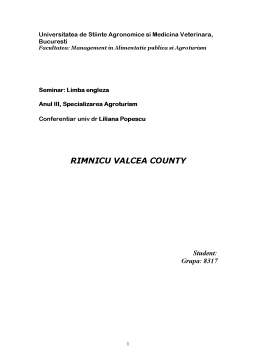Extras din referat
Vâlcea (also spelt Vîlcea) is a county of Romania, in the historical regions of Oltenia and Muntenia (both regions are separated by the Olt river), its capital city is Râmnicu Vâlcea.
Demographics
In 2004, it had a population of 416,908 and the population density was 71,7/km².
Geography
This county has a total area of 5,765 km².
The North side of the county is occupied by the mountains from the Southern Carpathians group - The Făgăraş Mountains in the East with heights over 2200 m, and the Lotru Mountains in the West with heights over 2000 m. They are separated by the Olt River valley - the most accessible passage between Transylvania and Wallachia. Along the Olt River Valley there are smaller groups of mountains, the most spectacular being the Cozia Mountains.
Towards the South, the heights decrease, passing through the sub-carpathian hills to a high plain in the West side of the Romanian Plain.
The main river is the Olt River crossing the county from North to South. Its main affluents are the Lotru River in the North and the Olteţ River in the South.
Râmnicu Vâlcea is situated in the central-south area of Romania. Set at the foothills of the Southern Carpathians, the city is located at about 12 km from the Căpăţânii Mountains, 17 km from the Cozia Mountains and about 40 km from the Făgăraş and Lotrului Mountains. The southern limit of Râmnicu Vâlcea is formed by the Getic Plateau and the Oltului Valley.
The Olt River crosses the town of Râmnicu Vâlcea as well as the E81 road of European interest and one of the main national railway routes.
The climate of Râmnicu Vâlcea is temperate-continental with average temperatures of 10 to 11° C.
History
It was documentary attested in 1370 as a princely residence of Vlaicu Voda. As a princely court, it was enforced during the reign of Patrascu the Good (1554-1557).
The area has been inhabited since Dacian and Roman times, and was the site of a castrum. A new fortress was built on the location during the Middle Ages. Râmnicu Vâlcea was first attested during the rule of Prince Mircea cel Batran, as "the princely town of Râmnic" (September 4, 1388), and confirmed as the seat of a Vâlcea County during the same period (January 8, 1392).
The town seal dates to 1505. Cetăţuia, the actual fortress, served as the residence of Oltenian Bans and, from 1504, of Orthodox bishops; in 1543, Prince Radu de la Afumaţi was killed in Cetăţuia by a boyar conspiracy.
During the rules of Matei Basarab and Constantin Brâncoveanu, it became an important cultural center. It was here where the first paper mill and printing press in Romania were built (see Anthim the Iberian). The city was heavily damaged during the Habsburg takeover of Oltenia between 1718 and 1739, and its purpose was again reduced to that of a fortress.
During the Wallachian Revolution, on July 29, 1848, Deşteaptă-te, române! (the current national anthem of Romania), with lyrics written by Andrei Mureşanu and music probably composed by Anton Pann (whose memorial house lies in the center of the town), was sung for the first time in Râmnicu Vâlcea. Gheorghe Magheru gathered his military force in Râureni, now part of the city, in an attempt to face the anti-revolutionary forces of Imperial Russia and the Ottoman Empire.
In the 1980s, the city was completely rebuilt in a style combining Socialist realism with local vernacular architecture.
Neighbours
- Argeş County in the East.
- Gorj County and Hunedoara County in the West.
- Sibiu County and Alba County in the North.
- Dolj County and Olt County in the South.
Economy
The city of Râmnicu Vâlcea is the most industrialised in the county, the rest of the county having an agrarian development.
The predominant industries in the county are:
- Chemical industry.
- Food and beverage industry.
- Textile industry.
- Mechanical components industry.
- Construction materials.
- Wood and furniture industry.
In the West of the county coal and salt are extracted.
The area in the center of the county is well suited for fruit orchards, wines and raising cattle. The South is better suited for growing cereals and vegetables.
Preview document
Conținut arhivă zip
- Rimnicu Valcea County.doc














